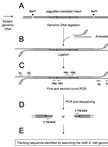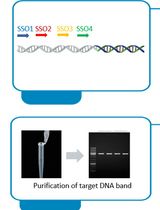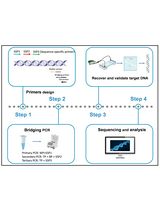- EN - English
- CN - 中文
PCR-RFLP Genotyping of Point Mutations in Caenorhabditis elegans
线虫点突变的PCR-RFLP基因型鉴定
发布: 2012年03月20日第2卷第6期 DOI: 10.21769/BioProtoc.128 浏览次数: 25803
Abstract
This protocol describes the basic principle of PCR/restriction digest genotyping of point mutations in worms, based on the principle of Restriction Fragment Length Polymorphism (RFLP) analysis. This type of genotyping is, particularly, useful when phenotypic analysis of animals carrying point mutations is difficult (e.g., in a complex genetic background).
I will illustrate the general procedures, using an example of daf-2 gene, encoding the sole insulin/IGF-1 receptor of C. elegans. Gems et al.(1998) did a very elegant job and characterized a series of mutations of daf-2, including the following two temperature-sensitive hypomorphic alleles:
daf-2(e1370): Substitution C/T (wild type/mutant), amino acid change: Missense P to S
Flanking sequences:
5’-CTCTATGAAATGGTTACACTCGGTGCTCAGCATATATTGGTTTGAGTAATGAGGTGT
Intracellular kinase domain, Class I, strong phenotype.
daf-2(e1368): Substitution C/T (wild type/mutant), amino acid change: Missense S to L
Flanking sequences:
5’-TCCGGAATTTACGTATTGAGGCAAAGTACTGTTCAGAAATVTATATGCTATCACAGT
Extracellular ligand binding domain, Class II, weak phenotype.
Here I will show you how to design the primers for PCR-RFLP analysis.
daf-2(e1370): Designed by Seung-Jae Lee from the Kenyon lab
Forward primer: 5’-CGGGATGAGACTGTCAAGATTGGAGATTTCGG-3’
Reverse primer: 5’-CAACACCTCATCATTACTCAAACCAATCCATG-3’
On the (-) strand, the nucleotide next to the 3’ end of reverse primer is G in wild-type allele, which is mutated to T in daf-2(e1370). Thus, by introducing another mutation (double C here, highlighted) into the reverse primer, it creates an Nco I-restriction site (i.e., CCATGG) only for PCR products derived from wild-type but NOT daf-2(1370).
daf-2(e1368): Designed by Peichuan Zhang from the Kenyon lab
Forward primer: 5’-GTTCCGGAATTTACGACGTATTGAGGCAACG-3’
Reverse primer: 5’-CTATCGGATCGAGTGGTATATTTAAC-3’
Similarly, on the (+) strand, the nucleotides next to the 3’ end of forward primer are TC in wild-type allele, and TT in daf-2(e1368). Thus, by introducing another mutation (C here, highlighted) into the forward primer, a restriction site of Acl I (i.e., AACGTT) is generated in the presence of daf-2(1368) point mutation.
The key is to introduce new mutation(s) at the 3’ end of one of your primers. Since the difference of the sizes of digest products is just ~30-bp, the length of the primer, you have to pick the other primer to generate an amplicon of ~200-bp – 250-bp or so.
Here is a website that can help you design the primers with appropriate restriction site for genotyping: http://helix.wustl.edu/dcaps/dcaps.html (dCAPS Finder 2.0) (Neff et al., 2002).
Materials and Reagents
- PK lysis buffer
- Proteinase K (Sigma-Aldrich, catalog number: P6556 )
- Common PCR reagent (e.g., Invitrogen PCR kit – Life Technologies, Invitrogen™, catalog number: 10342-020 ; or home-made Taq and buffer)
- Restriction enzymes (NEB)
- Agarose gel
- Ethidium bromide (Life Technologies, Invitrogen™, catalog number: 15585-011 )
- Plus DNA Ladder (Life Technologies, Invitrogen™, catalog number: 10787-018 )
Equipment
- MJ Research PTC-200 Thermo Cycler (MJ Research)
- Thin-wall PCR tubes (USA Scientific, catalog numbers: 1402-2700 or 1405-8100 )
Procedure
文章信息
版权信息
© 2012 The Authors; exclusive licensee Bio-protocol LLC.
如何引用
Zhang, P. (2012). PCR-RFLP Genotyping of Point Mutations in Caenorhabditis elegans. Bio-protocol 2(6): e128. DOI: 10.21769/BioProtoc.128.
分类
分子生物学 > DNA > 基因分型
分子生物学 > DNA > PCR
您对这篇实验方法有问题吗?
在此处发布您的问题,我们将邀请本文作者来回答。同时,我们会将您的问题发布到Bio-protocol Exchange,以便寻求社区成员的帮助。
Share
Bluesky
X
Copy link













